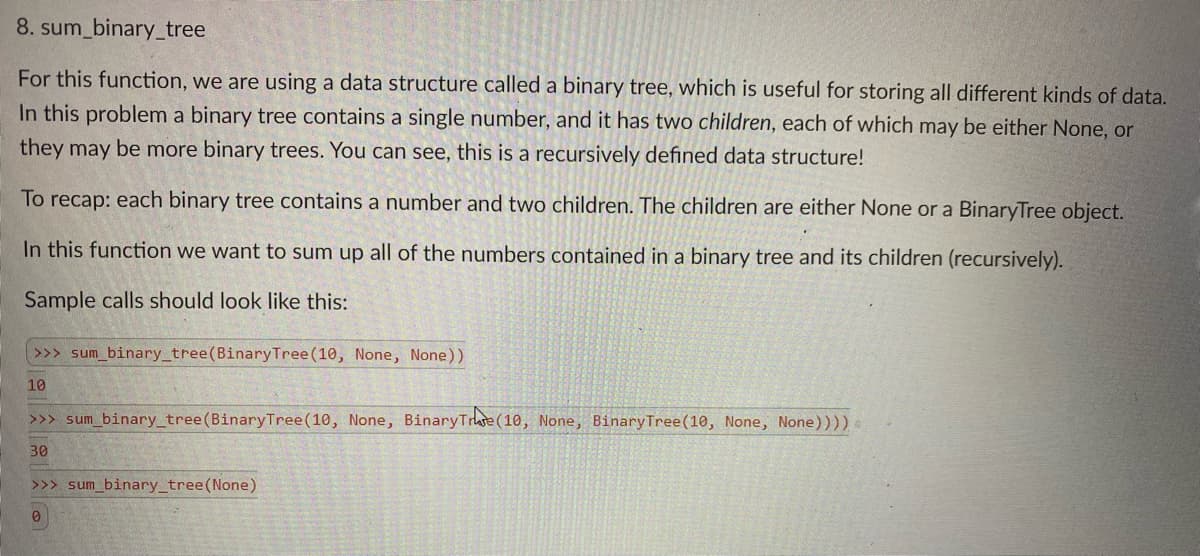8. sum_binary_tree For this function, we are using a data structure called a binary tree, which is useful for storing all different kinds of data. In this problem a binary tree contains a single number, and it has two children, each of which may be either None, or they may be more binary trees. You can see, this is a recursively defined data structure! To recap: each binary tree contains a number and two children. The children are either None or a BinaryTree object. In this function we want to sum up all of the numbers contained in a binary tree and its children (recursively). Sample calls should look like this: >>> sum binary_tree(BinaryTree(10, None, None)) 10 >>> sum binary_tree(BinaryTree(10, None, BinaryTrae (10, None, BinaryTree(10, None, None)))) . 30 >>> sum binary_tree(None)
8. sum_binary_tree For this function, we are using a data structure called a binary tree, which is useful for storing all different kinds of data. In this problem a binary tree contains a single number, and it has two children, each of which may be either None, or they may be more binary trees. You can see, this is a recursively defined data structure! To recap: each binary tree contains a number and two children. The children are either None or a BinaryTree object. In this function we want to sum up all of the numbers contained in a binary tree and its children (recursively). Sample calls should look like this: >>> sum binary_tree(BinaryTree(10, None, None)) 10 >>> sum binary_tree(BinaryTree(10, None, BinaryTrae (10, None, BinaryTree(10, None, None)))) . 30 >>> sum binary_tree(None)
Database System Concepts
7th Edition
ISBN:9780078022159
Author:Abraham Silberschatz Professor, Henry F. Korth, S. Sudarshan
Publisher:Abraham Silberschatz Professor, Henry F. Korth, S. Sudarshan
Chapter1: Introduction
Section: Chapter Questions
Problem 1PE
Related questions
Question

Transcribed Image Text:8. sum_binary_tree
For this function, we are using a data structure called a binary tree, which is useful for storing all different kinds of data.
In this problem a binary tree contains a single number, and it has two children, each of which may be either None, or
they may be more binary trees. You can see, this is a recursively defined data structure!
To recap: each binary tree contains a number and two children. The children are either None or a BinaryTree object.
In this function we want to sum up all of the numbers contained in a binary tree and its children (recursively).
Sample calls should look like this:
>>> sum_binary_tree(BinaryTree(10, None, None))
10
>>> sum_binary_tree(BinaryTree(10, None, BinaryTrate (10, None, BinaryTree(10, None, None))))
30
>>> sum_binary_tree(None)
Expert Solution
This question has been solved!
Explore an expertly crafted, step-by-step solution for a thorough understanding of key concepts.
This is a popular solution!
Trending now
This is a popular solution!
Step by step
Solved in 4 steps with 2 images

Knowledge Booster
Learn more about
Need a deep-dive on the concept behind this application? Look no further. Learn more about this topic, computer-science and related others by exploring similar questions and additional content below.Recommended textbooks for you

Database System Concepts
Computer Science
ISBN:
9780078022159
Author:
Abraham Silberschatz Professor, Henry F. Korth, S. Sudarshan
Publisher:
McGraw-Hill Education

Starting Out with Python (4th Edition)
Computer Science
ISBN:
9780134444321
Author:
Tony Gaddis
Publisher:
PEARSON

Digital Fundamentals (11th Edition)
Computer Science
ISBN:
9780132737968
Author:
Thomas L. Floyd
Publisher:
PEARSON

Database System Concepts
Computer Science
ISBN:
9780078022159
Author:
Abraham Silberschatz Professor, Henry F. Korth, S. Sudarshan
Publisher:
McGraw-Hill Education

Starting Out with Python (4th Edition)
Computer Science
ISBN:
9780134444321
Author:
Tony Gaddis
Publisher:
PEARSON

Digital Fundamentals (11th Edition)
Computer Science
ISBN:
9780132737968
Author:
Thomas L. Floyd
Publisher:
PEARSON

C How to Program (8th Edition)
Computer Science
ISBN:
9780133976892
Author:
Paul J. Deitel, Harvey Deitel
Publisher:
PEARSON

Database Systems: Design, Implementation, & Manag…
Computer Science
ISBN:
9781337627900
Author:
Carlos Coronel, Steven Morris
Publisher:
Cengage Learning

Programmable Logic Controllers
Computer Science
ISBN:
9780073373843
Author:
Frank D. Petruzella
Publisher:
McGraw-Hill Education